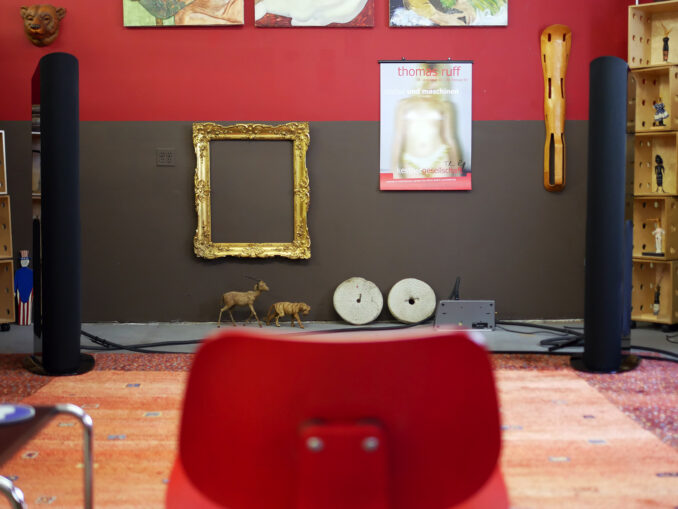
Full range. There are an abundance of words and phrases used to describe aspects of the reproduction of music, but few are as meaningful and without controversy as full range. In an ideal world, who wouldn’t want full range?
The GoldenEar Triton Reference Towers sit at the top of the Triton Series family of speakers. There are six speakers in the line in total, ranging in price from the Triton Seven Towers at $1598/pair, up to the Reference Towers at $9998/pair. What you get when you move up the Triton Tower liner is more speaker.
The Triton Reference Towers are a lot of speaker for the money. And I mean — they are a lot of speaker for the money.

The GoldenEar Triton Reference speakers house a total of 10 drivers that includes a powered subwoofer coupled to an 1800 Watt DSP-Controlled Class D Digital Amplifier. 1800 Watts. The driver complement, starting at the top (frequencies) consists of a high-gauss neodymium reference high-velocity folded ribbon (hvfr) tweeter, a pair of high-definition 6″ cast-basket reference bass/midrange drivers with focused field magnet structures, three 6″ x 10″ long-throw quadratic reference sub-bass drivers with focused field magnet structures, and four side-firing 9-1/2” x 10-1/2″ quadratic planar infrasonic radiators. That’s a lot of drivers, and a lot of different driver types, sizes, and styles to get to sing with one voice.

Frequency response for the Triton Reference is a claimed 12Hz – 35kHz which translates into RFR (real full range). Efficiency is rated at a perhaps surprisingly high 93.25dB, but remember, bass duties are handled in-speaker. The Reference Towers stand 58” tall, but their sleek front to back tapered stance, from about 7” to 9 1/4”, coupled with an all black appearance make them not very intrusive. At least here in the Barn, as you can see. A black fabric grille covers the entire front and wraps around to the sides where the mirror-like high gloss black cabinet takes over. The slender towers sit on a larger bass and the speakers ship with screw-in spikes and protective cups. I see the Triton Towers as handsome housemates and they are very nicely made.

The back, business side houses a panel at the base of each speaker that’s home to a pair of nice chunky binding posts, an RCA Sub input, a knob for setting the subwoofer’s level, a blue LED that shows operating status for the auto on/off sub, and an IEC inlet for delivering power to those 1800 Watt DSP-Controlled Class D Digital Amplifiers.
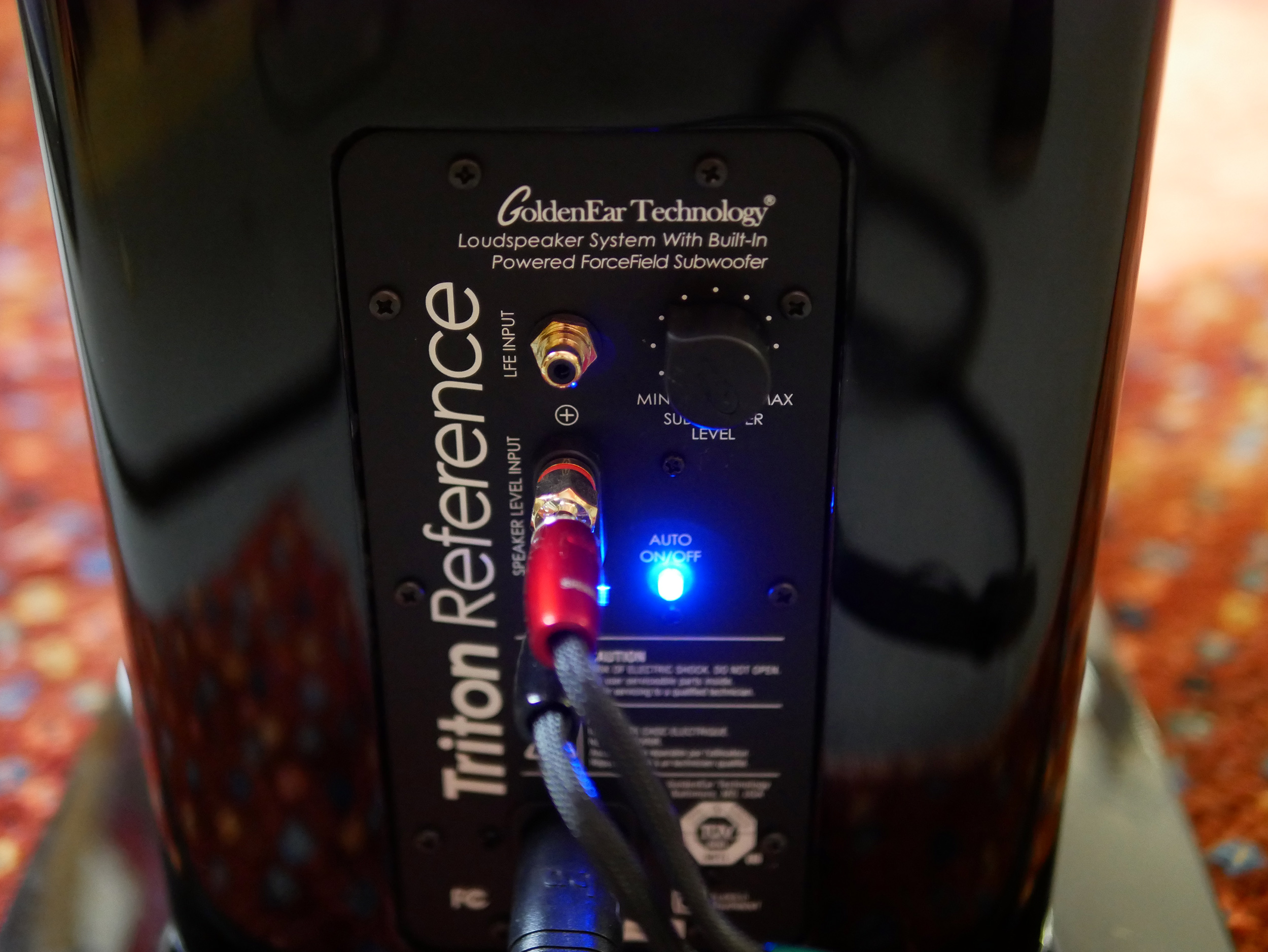
I paired the Triton Reference Towers with a number of amplification devices that included the Parasound JC 5 Power Amplifier paired with the Cambridge Edge A Integrated Amplifier acting as Preamp only, the Cambridge Edge A Integrated Amplifier all on its own, the Schiit Ragnarok 2 Nexus Integrated Amplifier, an Ayre EX-8 Integrated Hub, and the SAC Thailand Minute EL-84 Integrated Amplifier. Sources included the totaldac d1-tube DAC/Streamer, Cambridge CXC CD Transport, PS Audio PerfectWave SACD Transport, Denafrips ARES II DAC, and the Denafrips PONTUS II DAC. Everything was wired up with cables from AudioQuest.
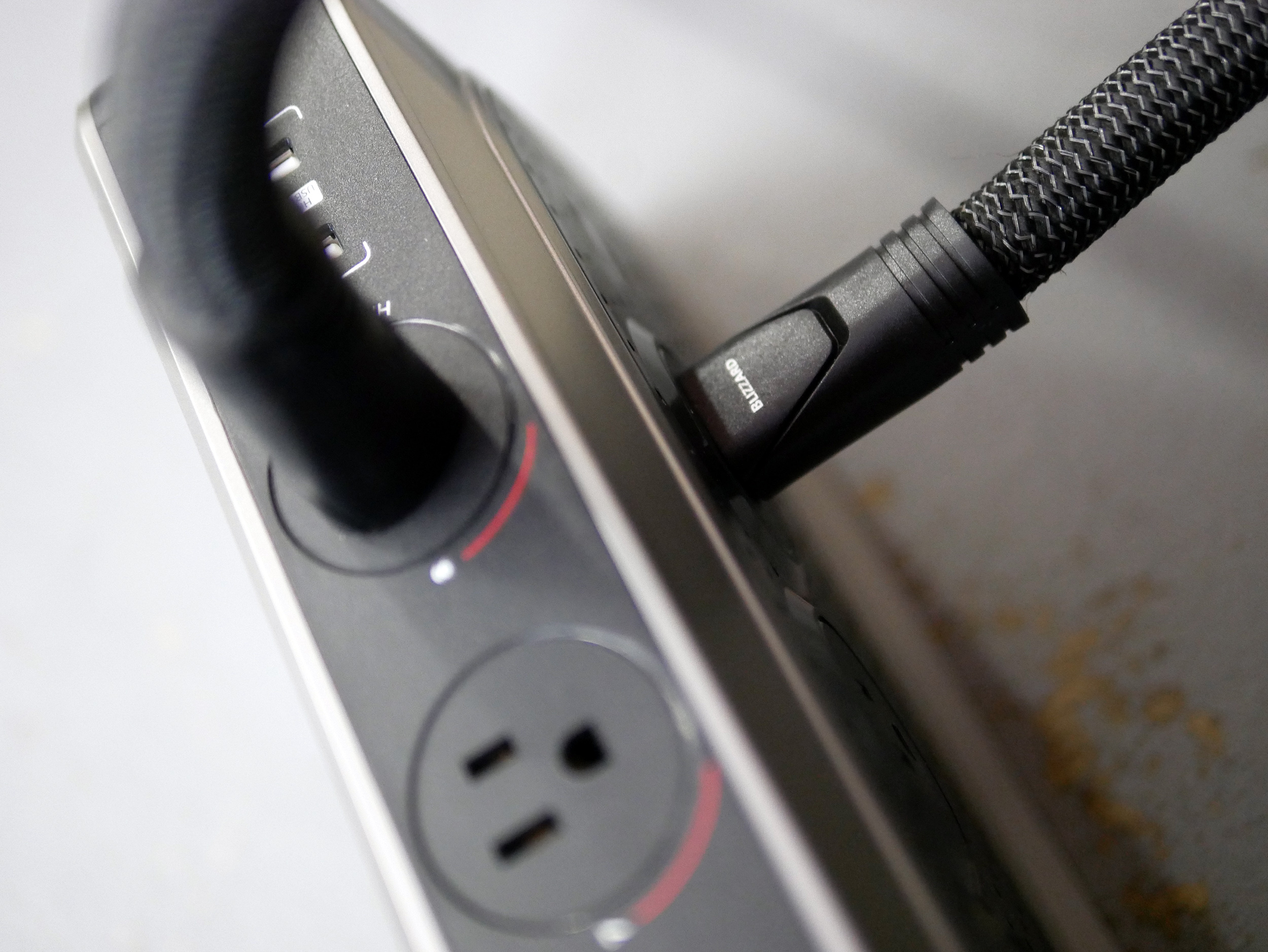
I will also note that I substituted a pair of AudioQuest Blizzard power cords for the stock cords that ship with the speakers, and the Blizzards were plugged into an AudioQuest PowerQuest 3 because doing so provided an appreciable improvement in sound quality.

A Game Of Inches
That lovely big red carpet that covers a fair % of the listening area’s floor in the Barn is not centered. While it looks like its sitting square in the middle of the space, that’s an optical illusion as it sits closer to one side than it does to the other. This may seem like “Who Cares” information but it’s turned out to be an inadvertent experiment of sorts.
The Triton Towers, which weigh about 110 lbs., arrived just a few days before I had one of my hernias fixed. The procedure left me unable to lift anything over 25 lbs., putting me, and the Towers, in a bit of a pickle seeing wrestling them from their coffin-sized containers is clearly a two-man job, leaving me, in my then current state, two men shy. Thankfully, the cavalry arrived to save the day.

Stephen Mejias, AudioQuest’s Director of Communications (performing the reveal above), and Chris Volk, Regional Sales Manager for GoldenEar and AudioQuest, [footnote 1] showed up one Spring day at the barn to do the unpacking and setup honors, post procedure. I had the speaker sweet spot marked with blue painter’s tape and it didn’t take very long at all before Stephen and Chris had the Towers singing sweetly. We spent some more time listening to music, sharing some favorite tunes, and doing some last minute placement and toe-in tweaking before the cavalry went on their way. Perfect!
Even though the Triton Towers had been burned in by GoldenEar before they made their Barn journey, I let them play, non-stop, for a number of days before I sat down to listen in critical listening mode. And when I did, something was a bit off. It sounded like I was hearing all of those drivers arguing with one another over who was more important, which in turn made music sound a bit confused. As you might expect.
Hmm, I thought. I’ve heard something similar happen with other speakers in Barn, and the cause is typically room placement. But, I thought, we measured when we moved the Triton Towers with my trusty old Stanley Powerlock, making sure everything was even. Then I looked at bases of the Reference Towers and saw that they were sitting perfectly centered on that big red rug. Aha! My inadvertent experiment proved, once again, that the pull of visual symmetry had won out, and somewhere in the final stages of our placement tweaking and toe-in, we’d moved the right speaker too far to the left.
It took all of about 4 inches to right this wrong, and in doing so the Triton Reference Towers began to sing with one voice. Problem, as they say, solved.
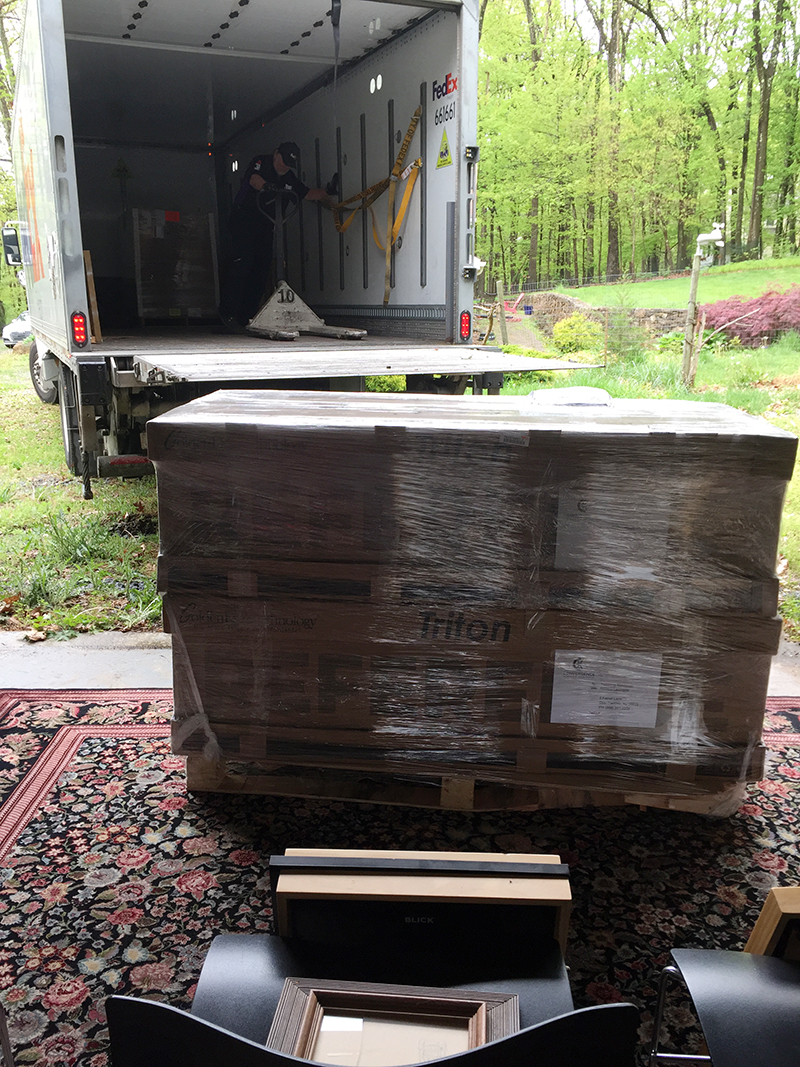
That’s A Lot Of Speaker
One day, at dusk, I was listening to the Triton Tower speakers when a family of deer walked by the half opened Barn door. A big buck, must have been at least a 12 pointer, lowered his head in through the open door and commented while chewing, “That’s a lot of speaker.” To which the doe added, “That’s a lot of speaker, especially for the money.” And they went on with their journey to wherever deer go at dusk.
The GoldenEar Triton Reference Towers are a lot speaker, especially for the money. This fact is so obvious, I hardly feel I need to write it out. The thing of it is, just like a heaping plate of grub, you really don’t know about the important stuff until you start chewing. I spent the better part of 5 weeks listening to the Triton Reference Towers with a number of amps, ranging in power output from about 2 Watts to 400 Watts, and I am very happy to report that the GoldenEar Triton Reference Towers are, in fact, a lot of speaker for the money — where it counts.
Big and bold yet surprisingly supple, the Reference Towers were happily relaxed playing all of the music I sent through them. From the intimate folky crooning of Luluc singing Nick Drake’s “Fly” live, from Way To Blue: The Songs of Nick Drake, to Cold Cave’s Latest foray into retro emo Fate In Seven Lessons, to András Schiff’s captivating take on Robert Schumann’s Geistervariationen (Ghost Variations), and everything in between, the Triton Reference Towers presented a big, tall, and rock solid sound image, one that made the notion of getting into the music feel like it was just a few short steps away.

In terms of dance partners, I enjoyed each of the amplifiers I paired with the GoldenEar speakers. I put the Tower’s efficiency rating to the torture test with the minute Minute EL84 integrated amp from SACThailand that pumps out about 2 Watts of power. I didn’t really expect much from this pairing, maybe some barely audible pained squeals, but lo and behold, music, sweet music, poured forth. And I do mean sweet, as the little Minute and its EL84s, I’ve yet to hear a bad sounding EL84 amp, offered the sweetest sounding mid to upper frequencies to pour out of the Reference Towers as compared to all the other amps I had on hand. I would go on to describe this pairing’s sound as very nicely ripe and timbrally rich, making for that lovely connection to music’s full voice.
That said, I would not recommend pairing the GoldenEar Triton Reference Towers with a 2-Watt tube amp because you won’t get to hear the best of either. The little Minute ran out of steam pretty quickly when pushed, which is not really shocking news. But the Minute EL84/Towers pairing did suggest to me that something very much like the Leben CS600 would be a wonderful partner for the Reference Towers, if you’re looking for tonal riches plus power.
My favorite amplification partner for the GoldenEar Triton Reference Towers was the Ayre EX-8, hands down. I’ve lived with the EX-8 for coming up on a year, and previously owned and loved the Ayre AX-5 Twenty and to my ears, Ayre amplification offers a wonderful mix of refinement, brawn, and sparkle. When used to power the Triton Reference Towers, the resultant music pouring into the Barn was rich, refined, beautifully nuanced, and powerful. If pressed, I bet I could nearly guess Nick Drake’s height and weight as he sang “Day Is Done” (I don’t know about you, but whenever I listen to a cover version, I almost immediately want to hear the original). The Triton Towers, as you’d expect, throw out a big sound image, huge actually, that feels solid and right, and compared to other speakers I’ve had in barn, much taller. With the Triton Towers’ 6″ bass/midrange drivers sitting about 50 inches off the floor, height is kinda expected.
Regular readers know that my daily drivers are the DeVore Fidelity O/93 speakers ($8400/pair), which I suppose could be more different as compared to the Triton Towers, but these are fairly different kinds of speakers. The DeVore’s are a two-way, comparatively short and stout speaker that are also very easy drive. The company rates their frequency response at 30Hz-31kHz, so fairly full range. I’ve been living with the O/93s for about a year, and have also owned and enjoyed the DeVore gibbon X, gibbon Super Nine, and gibbon Super 8. You could say I’m very familiar with the sound of DeVore speakers, and I wouldn’t argue the point.
Captain Obvious found that the Triton Towers sounded bigger and bolder than the O/93s. No surprises here, even if you’re only looking at pictures. But this kinda odd comparison also spotlighted one of the things I so enjoy about the DeVore’s, and that’s their sense of immediacy. The O/93s feel as if they nearly anticipate the moments in music that are coming next, they do such a wonderful job of conveying energy, the subtlest of nuance, and the big swings of drama. Comparatively speaking, the Triton Towers sound a bit less lively, less nimble, as if they need a bit more volume to truly come alive.
Over time, this sense of a minimum volume level became more evident when listening to the Triton Towers. At lower volumes, in the voluminous space that is the Barn, music could feel a bit disjointed and not fully formed. To be clear, I’m talking about listening levels that are easy to talk over, so not the levels I listen to when music is my sole focus. I mention this finding for those who live in situations where volume may be an issue, whether due to neighbors or sleeping friends or family.
There are a few albums, and more specifically tracks from albums, I use to see what’s up with bass, and very deep bass. One such example is “Coax” from Raime’s Tooth, where, at 2 seconds in, a sub 30Hz note drones and at the right volume level, sets some things in the barn a rattling. Of course the speaker doing the driving has to have the chops to deliver this energy in room, and the Triton Towers passed this rattle test with more than flying colors. Listening at even modest levels — for this music — with 85dB peaks, I heard a distinct rattle coming from behind the listening chair. Turning sonic detective, I traced the source to one of the framed pieces of art that leans against the giant garage door, located 18’ behind the red Eames chair, or nearly 30’ from the speakers. “Coax” played through the Triton Reference Towers, had that picture vibrating against the garage door as if we were situated on an active fault line. Cool.
While we’re focused on deep bass, it’s worth mentioning that the subwoofer level knob came in handy, and I found a setting 2 clicks down from 0 was the perfect fit for the Barn. Thankfully, this was a set it and forget it kinda deal as I’m not a fan of fussing with things like subwoofer level as an ongoing task.
Getting back to comparisons, I also found that the Triton Towers were not as transparent as the DeVore O/93s, but in my experience this is an area where the DeVore’s excel. What I’m talking about is the sense that the speaker effectively removes itself from the listening experience, leaving no trace on the music that its responsible for the sound we hear. A disappearing act that offers a direct connection to the music. While the Triton Reference Towers offer a very engaging, colorful, and finely nuanced presentation, they did not match the DeVore O/93’s seemingly untouched sense of clarity. Mind you, the GoldenEar’s other strengths may, for some listeners, make this distinction pale in comparison.
Where the Triton Reference Towers bettered the DeVore’s is their ability to present a huge, voluminous sound image that, at the right listening levels, was rock solid, powerfully seamless from top to bottom, and reached to music’s basement and well into its subterranean wilds. If you enjoy big, bold music and want it to sound big and bold and exciting, the GoldenEar Triton Reference Towers were made for you.
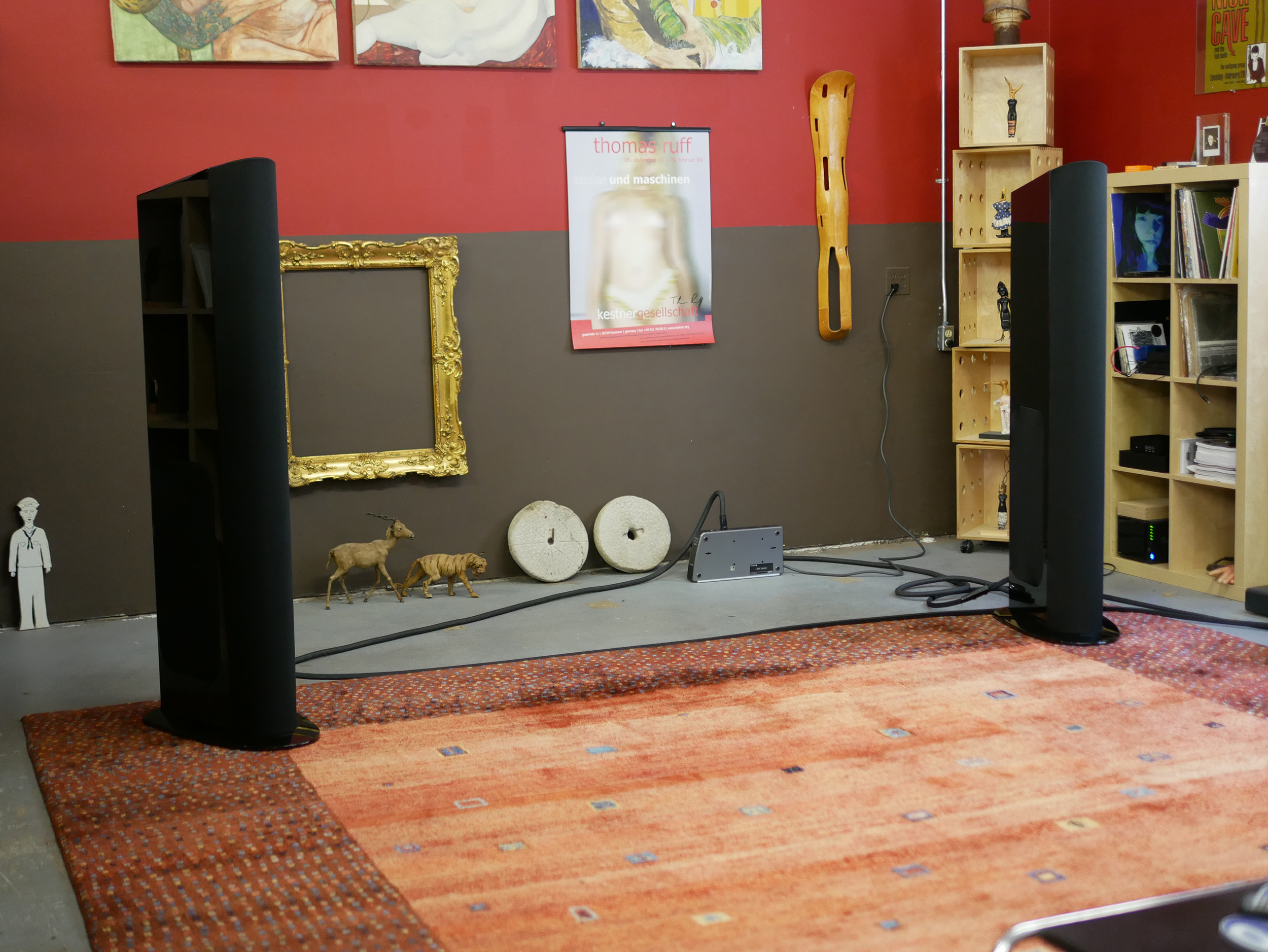
A Lot Of Speaker For The Money
Over my time with the GoldenEar Triton Reference Towers, I came to appreciate all they do, and they do so very much. In the Triton Reference Towers we have a true full range speaker that does not demand a lot of power while delivering music as big, rich, bold and beautiful as I’ve had the pleasure to hear. Bravo!
- GoldenEar was founded in 2012 by Sandy Gross and Don Givogue, both formerly of Definitive Technology and Sandy formerly of Polk Audio before that. The Quest Group, owner of AudioQuest, purchased GoldenEar in January of 2020.
GoldenEar Triton Reference Tower Speakers
Price: $9998/pair
Specifications
Frequency Response: 12 Hz – 35 kHz
Efficiency: 93.25 dB
Nominal Impedance: Compatible with 8 ohms
Driver Complement: Three 6″ x 10″ long-throw quadratic Reference subwoofers, coupled to: Four 9-1/2″ x 10-1/2″ quadratic planar infrasonic radiators, Two 6 ̋ high-definition cast-basket Reference mid/bass drivers, One high-gauss Reference High-Velocity Folded Ribbon (HVFR™) tweeter
Rec. Amp: 20 – 750 Watt/channel
Built-In Subwoofer Power Amplifier: 1800-Watt ForceField digital/56 bit DSP subwoofer amplifier
Power Requirements/Consumption: Low voltage version – 120 V at 60Hz / 1800 Watts. High voltage version – 240 V at 50Hz / 1800 Watts (approved for NA (TUV) and the CE market)
Dimensions: Speaker: 9-1/4″ W x 18-3/4″ D x 58″ H (w/ base) Base:13-5/8″ W x 22-1/4″ D
Weight: 110 lbs
Company Website: GoldenEar

